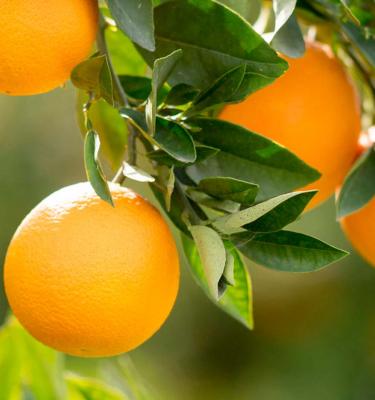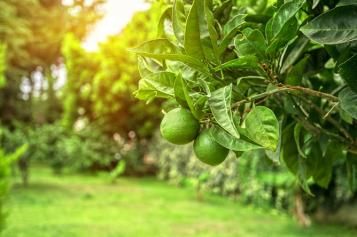
Citrus Tree Growing Guide: How To Grow and Care for Citrus Trees
Having a lemon tree in the backyard was once the great Australian dream. Now it’s a citrus tree orchard with limes, blood oranges, and mandarins rivaling the humble lemon for space and pride of place.

Citrus trees are evergreen trees that can be grown in pots or in the ground but will need year-round care.
Luckily, citrus trees are dead-easy to grow and produce an abundant harvest in only a couple of years from planting. To reap the rewards year after year, follow this simple citrus regime.
- Planting
- Watering
- Fertilising with Scotts Osmocote® Controlled Release Fertiliser
- Pest and disease prevention
- Pruning
Caring for your citrus trees
Whether you’re growing a lemon, lime, mandarin, orange, grapefruit or tangelo, caring for your citrus tree has never been easier. Follow these four simple tips to keep your trees healthy and happy.

Planting citrus trees
The right time to plant your citrus tree depends on where you live in Australia. In cooler parts of the country, wait until spring when the soil is warmer to plant. For warmer areas, you can plant a citrus tree in your garden in autumn. You should always avoid planting a citrus tree in the heat of summer.
You can transplant citrus plants directly into your garden. Just make sure you use both Scotts Osmocote Compost Premium Soil Improver and Scotts Osmocote Plus Organics Citrus & Fruit Plant Food & Soil Improver. You also have the option of planting citrus trees in pots in your garden – read our tips and tricks for planting fruit and citrus trees to find out exactly how to do it.

Watering citrus trees
Water citrus trees deeply twice a week during establishment.
The frequency of watering can be cut back when citrus trees are established, so you're only watering during dry periods and when fruits are developing.
It’s important to maintain soil moisture from fruit set to harvest to prevent citrus trees becoming stressed, which could result in a significant part of the crop dropping before it's ripe.

Fertilising citrus trees
Fertilise citrus trees at the start of autumn and spring. Apply a generous amount of Scotts Osmocote® Controlled Release Fertiliser for Citrus & Fruit to the soil around your tree. The controlled release technology only feeds when the plant needs it most, helping sustain healthy growth all season long.
Here’s how:
- Clear any mulch from the area immediately beneath the tree canopy.
- Sprinkle some Scotts Osmocote Controlled Release Fertiliser, in a band around the dripline (immediately below the external perimeter of the foliage).
- Water well.
- Replenish the mulch.
NOTE: The application of controlled release fertilisers in addition to the organics will help to ensure a range of nutrients is available to your citrus trees when they need it most.
For more information on fertilising citrus trees, visit our page fertilising fruit and citrus trees.

How to keep pests and diseases away from citrus trees
Problems with pests and diseases can be largely avoided by ensuring your citrus trees are healthy.
To give your citrus trees the best possible start:
- Prepare the soil prior to planting by enriching with compost.
- Dig a hole at least twice as large as the pot your citrus trees comes in so roots are not damaged.
- Plant citrus trees in full sun - at least 5-6 hours of sunlight per day.
- Apply Scotts Osmocote® Controlled Release Fertiliser at the best time, which is during autumn and spring.
Of course, no matter what you do, sometimes pests and diseases can attack your citrus trees. Look out for:
- Scale, leaf miners and aphids. These are common citrus pests but rarely cause major damage. Treat with an environment-friendly oil spray.
- Stink bugs can cause damage to your tree and harvest. Remove by hand immediately (make sure you are wearing gloves and eye protection).
- Yellow leaves are a common complaint with citrus trees but if you have prepared the soil well and replenish it each season, your citrus will survive. Look for fertilisers with boosted magnesium and iron to assist in the prevention of yellowing.

Pruning citrus trees
When it comes to pruning, citrus trees are quite different to the majority of fruit trees because they are evergreen. Forget all those fancy pruning techniques and simply:
- Remove old or dead wood.
- Remove any unwanted growth or branches touching the soil.
- Reduce overall height and maintain a neat shape (if you want).
That’s all there is to it - caring for your citrus trees couldn’t be easier!
When to pick citrus fruit
The right time to pick your citrus fruit will depend on where you’re based in Australia, but you can use the following as a guide:
- Lemons: January to April
- Limes: January to April
- Grapefruits: Year round
- Mandarins: April to October
- Valencias: November to February
- Navel Oranges: June to October
Look for fruit that’s reached a mature size and smell it to see if it gives off a citrus aroma. To really be safe and sure that the fruit is ready to pick, peel one and give it a taste. This is the guarantee you need to know it’s ready to be eaten or to be used in your cooking.
Ready to plant citrus trees in your garden and enjoy a zesty treat at home? Remember to follow the above tips for a bumper harvest. If you’re looking to grow more fruit and veg in your garden, discover our 10 easy steps to grow your own food at home.
FAQs
How do you hard prune a citrus tree?
Hard pruning a citrus tree in Australia is best done in late winter to early spring (August to October), depending on your climate. Warmer areas can prune from late winter, but in cooler regions, wait until early spring once the risk of frost has passed. Remove dead, diseased, or damaged branches, and cut back any overly long or crossing limbs to boost airflow. Keep it in check—prune no more than 25% at a time to avoid stressing the tree.
What are the best types of pots for citrus trees?
The best pots for citrus trees in Australia are large, well-draining containers made from terracotta, ceramic, or plastic. Make sure your pot has drainage holes to prevent waterlogging, and go for a size at least 45-50 cm wide and deep to allow healthy root growth. Avoid self-watering pots, as citrus trees prefer soil that dries out slightly between watering. A slightly larger pot will encourage stronger, more productive growth.
When to transplant citrus trees in Australia?
The best time to transplant citrus trees in Australia is late autumn to early spring (April to September), depending on your climate. In warmer regions, autumn is best so the tree can settle before summer. In cooler areas, early spring is ideal once the risk of frost has passed. Avoid transplanting in extreme heat or frost, as this can stress the tree.
What is the best fertiliser for citrus trees?
For citrus trees in Australia, use a fertiliser specifically formulated for citrus or fruit trees. Look for a balanced blend of nitrogen, phosphorus, potassium, and magnesium to support strong growth and fruiting. Apply in spring and again in late summer for best results. Slow-release fertilisers provide steady nutrients, while liquid feeds can give an extra boost during active growth. Organic options like compost or aged manure can also help improve soil health.







